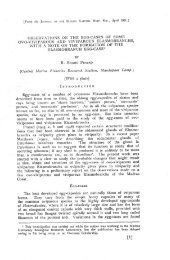PDF - Eprints@CMFRI
PDF - Eprints@CMFRI
PDF - Eprints@CMFRI
You also want an ePaper? Increase the reach of your titles
YUMPU automatically turns print PDFs into web optimized ePapers that Google loves.
179<br />
,"Iarine Science, Cape Ferguson ; Dr. H. DITLEV, University of Aarhus, Institute of Genetics and Ecology;<br />
Prof. Dr. Y. LOVA , Tel Aviv University, Zoology Department; Prof. Dr. H. MERGN ER, Universitat Bochum,<br />
Institut fUr Spezielle Zoologie; Dr. B. R. ROSEN , British Museum (Natural History) London; Dr. J . E. N.<br />
VERO, , Australian Institute of Marine Science, Cape Ferguson; Dr. C. WALLACE, James Cook University<br />
of orth Queensland , Townsville; Dr. M. WIJSMANN-BEST, Rij ksmuseum va n Natuurlijke Historie, Leiden.<br />
In additio n, we are thankful to: Mrs. A. SCI·IEER, Darmstadt, for assistance in compiling the Index,<br />
thorough text revision and assistance in reading the proofs ; Mrs. U. DOERK EN·SCHEER and Mrs. M.<br />
EB INGER , Bornhei m, for translating various parts of the manuscript; W. KUMPF , Hessisches Landesmuseum<br />
Darmstadt, fo r taking photos of part of the corals, and for making all enlargements, assisted by<br />
E. ,"IANTHE I; H. MU ELLER , Darmstadt, for the graphic design of the tables.<br />
Fi nally , we thank the Alexander von Humbold t Stiftung for subsidizing the printing costs of this work.<br />
Abstract<br />
A historical survey on Red Sea coral research covers the period from the first coral illustration of<br />
T. SHAW (1738) to H. FRICKE'S submersible, which he used in 1981 to dive down to a depth of 200 m<br />
and to collect corals. The research work proper started with P. FORSKAL (1775). In 1834 C. G. EHREN·<br />
BERG published the results of a trip to the Red Sea wh ich he had made together with F. W. HEMPRI CH.<br />
C. B. KLUNZINGER wh o had lived in Koseir for many years and who recorded the results of his work in<br />
three volumes ( 1879), probably made the most valuable co ntribution on Red Sea corals. Another important<br />
contrib ution on the coral fa una of the Red Sea came from E. v. MARENZ EL LER who also was the fi rst to<br />
describe deep sea corals (1906). C. CROSSLAND, too, head of the Sudan Pearl Fishery and founder and<br />
first director of the Marine Bi ological Station Ghardaqa (1922- 1938), made valuab le contributions to<br />
coral research.<br />
From 1968 to the 70ies the Cambridge Coral Starfish Resea rch Group in Port Sudan also dealt with<br />
the corals of the local reefs (HEAD , 1980). In 1968 Israel's Marine Biological Laboratory was founded in<br />
Eilat in the north of the Gulf of Aqaba, an institution which produced a lot of contributions to coral<br />
research (e. g. LOVA & SLOBODKIN, 197 1). Last but not least, there are the funda mental works of<br />
H. MERG ER and H. SCHUHMACHER (1974-1981) on the investigation of the coral reefs near Aqaba.<br />
In addition to the corals collected in the Red Sea by G. SCH EER 1957 and 1962 and by H. FEUSTEL<br />
1968, the Hessische Landesmuseum Darmstadt received sizeable coral collections from the Universities of<br />
Jerusalem, Tel Aviv and Basel , fro m the U.S. National Museum of Natural Hi story Washington, from the<br />
Institute of Oceanography Port Sudan, and from diving expeditions of the sports teacher J . HOLLOSL<br />
Further collections came from the Universitat Bochum, fro m the Museum fiir Naturkunde, Berlin, from<br />
the Marine Research Laboratory Sf. Petersburg (Florida), and from H. FRICKE's deep·diving projects.<br />
Moreover, the Hessische Landesmuseum Darmstadt also possesses an old coral collection including 33<br />
duplicates fro m KLUNZ I GER. A special chapter of the In troduction consists of a tabular summary of<br />
the colleclions, listing the locations - which are also marked on maps - , the inventory numbers and<br />
mentioning depth data.<br />
The systematic part of the present report deals with altogether 2074 corals that were ascribed to 194<br />
species from 70 ge nera. Of these, 16 1 species from 51 genera with 1976 specimens are reef corals. The<br />
remainder, 33 species from 19 genera with 98 specimens are ahermatypic corals. All 194 species are described,<br />
their affinities discussed, and information is given abour their geographical distribution. 176 species<br />
are figured. Four species are described as new to science, and 22 species were found for the first time in<br />
the Red Sea .<br />
24 Zooiogicli . 133
















